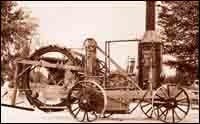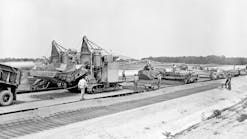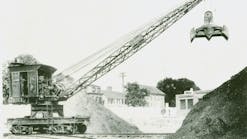The No. 88 ditcher has a 7½-foot digging wheel and 5-foot-high steam boiler. It worked in Oklahoma until 1936, when it became a display piece. Today it's on display in Findlay, Ohio. Photo courtesy of Hancock Historical Museum.
James B. Hill claimed to have built the world's first ditching machine. Recognizing the need for a practical way to place underground drain tile in the field, he built a steam-driven ditching machine while working in a machine shop in Bowling Green, Ohio. He founded the Buckeye Steam Ditcher Co. and patented his machine in 1894. After some lean times experimenting and perfecting several more machines, Hill became associated with Van Buren Foundry and Machine Co., which built his ditchers on a royalty basis. A new partnership, Van Buren, Heck & Marvin Co., was founded in 1902 in Findlay, Ohio, to build steam-powered ditchers to Hill's design.
The machine shown, known as the No. 88, was built in 1902 and is equipped with a 7½-foot digging wheel and 5-foot-high steam boiler. It spent time working in Oklahoma until it was rescued in 1936 by the company for use as an advertising feature. After that, it took part in many county fairs and was displayed in front of Buckeye's plant. Finally, it was donated to the Hancock Historical Museum, Findlay, Ohio, where it survives on display with most of its original parts.
In 1906, the company changed its name to the Buckeye Traction Ditcher Co., and for the next half century, the Buckeye name was attached to a wide range of wheel and ladder ditchers that were held in high regard by ditching and land drainage contractors. In the early part of the 20th century, the product line spanned a big range from the small 10-hp gasoline-powered Model O wheel ditcher to steam-driven monsters capable of digging a trench 54 inches wide by 12 feet deep. By 1919, huge wheel ditchers (some weighing more than 70 tons, measuring 55 feet in length and propelled on massive 8-foot-wide crawlers) were leaving the factory.
Buckeye continued to develop many sizes and types of ditching machines throughout the 1920s and 1930s. By the early 1940s, the range included 10 wheel ditchers and six ladder ditchers. The largest wheel could dig a trench 4 feet wide by 8 feet deep at rates up to 10 feet per minute, depending on the material. Buckeye's big ladder ditchers reigned supreme on deep sewer and water lines. The Model 260, dating from the early 1940s, was fitted with a 125-hp diesel engine and boasted a digging depth of 24 feet for trenches up to 52 inches wide.
In 1947, the Buckeye Traction Ditcher Co. was purchased by Gar Wood Industries, which continued the Buckeye products. In 1971, Gar Wood became a division of Sargent Industries, and ditcher production was transferred from Findlay to Wayne, Mich. By that time, though, ditcher sales were dwindling, and the machines were produced only a short time under Sargent's control. The Wayne plant closed in 1972 when production ended.
You can read more about the evolution of construction equipment in Keith Haddock's illustrated book "The Earthmover Encyclopedia," available in most bookstores. Also, consider a membership in the Historical Construction Equipment Association, www.hcea.net.





